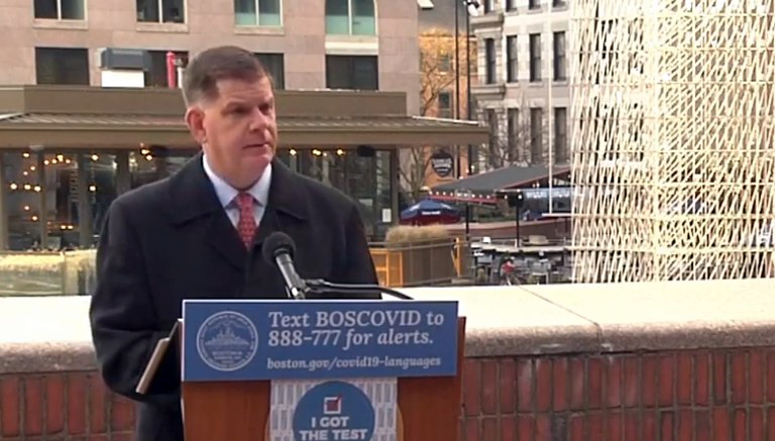In the state’s two largest cities, officials are cautiously eyeing the latest coronavirus data to keep watch for the impact of Thanksgiving get-togethers and girding themselves for what could be a very dark few weeks.
Boston Mayor Martin Walsh said the COVID-19 data was trending in the right direction with an increase in testing and decrease in new cases during the two weeks leading up to Thanksgiving, but he said the city confirmed 407 new cases of the virus Tuesday — more than double the daily average of 183 new cases for the week that ended Nov. 23.
“We’re going to be monitoring the data closely as it comes in to make sure that we don’t see these large spikes. That 400 number has been the largest, honestly I think since June; we haven’t had a day that big. So we’re going to, tomorrow and the next couple of days, see what the numbers look like,” Walsh said.
The mayor said Boston’s positive test rate averaged 3.4 percent for the same one-week period, which was down from 5.4 percent the previous week. Every Boston neighborhood saw its positive test rate decline and the average number of tests processed each day has been steadily increasing for the last month, Walsh said. But the spike of 407 new cases Tuesday is concerning, he said.
“It could be the first signs of what the Thanksgiving holiday brought,” Walsh said. He added, “So we’ve just got to see what’s going to happen now and I think over the course the next five to 10 days we’ll know exactly what the impacts, if there are any … I can’t count the 400 all to Thanksgiving but I’m sure it has something to do with it.”
In the state’s second-largest city, public health officials are similarly concerned that Thanksgiving travel and gatherings will throw the current COVID-19 surge into a higher gear. Worcester Medical Director Dr. Michael Hirsh said Monday morning on Talk of the Commonwealth with Hank Stolz that he is worried the situation will only continue to worsen.
“This is gonna be a big, bad, ugly six weeks, I think Hank, because a lot of what we were seeing with the number last week were still a reflection of, I believe, Halloween weekend. And then we have superimposed now this bump, which I think will come out about the middle of December. And then Christmas, where that whole week will be lots of traveling and into New Year’s,” he said. “By the time all these cumulative bumps happen, it’s going to be mid-January and I think the vaccine will be here by then but it’s going to tax the hospitals terribly.”
The field hospital the state is standing up again at the DCU Center in Worcester is expected to open Dec. 6, Hirsh said. “None too soon,” he said.
As of Sunday, 67 percent of the 1,200 non-ICU beds in Central Mass. hospitals were occupied and half of the region’s 200 ICU beds were full, according to the Department of Public Health. In the Boston area, 71 percent of 3,400 non-ICU beds were full and 57 percent of the 700 ICU beds in the area were occupied, DPH said. Statewide, 66 percent of non-ICU beds and 50 percent of ICU were full as of Sunday.
“We don’t have shortages of PPE and ventilators and all of that stuff, but we definitely have a squeeze going on for beds and we unfortunately also have a squeeze going on with health care staff,” Hirsh said. He added that people are underestimating how easy it is to catch the coronavirus with so much of it circulating in the community.
On Tuesday afternoon, the Worcester Business Journal reported that UMass Memorial Health Care in Worcester had moved into its emergency operations plan “because of a critically high number of patients.”
Walsh said Boston is watching hospitalization rates “really closely” but is not seeing the same kind of activity in hospitals and emergency rooms that took place in April.
“We are seeing activity at hospitals, but not the same. And that’s really the big number that’s the difference between keeping a restaurant open and shutting a restaurant down. That’s the difference between keeping a business open and shutting a business down, is the hospitalization,” the mayor said. “If we get to a point where our hospitals are over capacity, where it’s affecting other illnesses that people get treated for, that’s when we’ll be having a very, unfortunately, having a very different conversation here.”
Last week, buoyed by a few weeks of positive trends, Walsh said that if the trend holds “we actually can have conversations, probably pretty soon, about bringing people back into schools.” On Tuesday he said he does not envision schools reopening fully before the holiday break later this month.
“I’m hopeful that in the course of the next couple weeks I’ll be able to stand here with a plan on how we’re going to reopen our schools in Boston and I’m not anticipating schools reopening fully before Christmas, the Christmas break, but I am expecting that we’ll be able to have some clarification on what the phased reopening is going to be after Christmas,” he said.
Walsh added, “As we continue to move forward, if we get these numbers down and we set benchmarks — and we’re below those benchmarks right now — we will begin the process of hopefully reopening schools right after the new year, hopefully.”
(Copyright (c) 2024 State House News Service.

